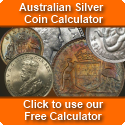Coin blanks are imported by the Royal Australian Mint in huge 44 gallon drums pre cut ready to be fed straight into the presses. These huge drums of blanks are moved around the mint by the "Titan" robot seen here (I'm trying to paint a picture in your head). Factories overseas process strips of metal and cut out the coin blanks for many countries right around the world, with some companies producing blanks for more than one country.
Fast forward now to newly pressed one dollar coins leaving the RAM in bags to the Armaguard facility to be rolled into manageable $20 lots before distribution to banks and major retailers Australia wide. A particular mob of roos one dollar is packaged into a roll destined for a Woolworths supermarket. The checkout chick cracks that roll and the shiny new loose dollars are in the till ready to be given out as change. One very lucky lady is given one of these dollars in her change and gives this coin a second look as she leaves the supermarket. When she gets home she has a third look at her coin which looks just a bit different to all the other mob of roos dollars she has seen before.
This lucky lady has just won the lottery, she just doesn't quite know it yet. Those in coin coin collecting circles would gasp at what this coin is.... shall I share?
This 2009 mob of roos one dollar coin has spectacular eye appeal, it looks to have been struck on a foreign bi-metal planchet! Now the chances of a foreign blank of distinguishable difference getting into the drum of blanks, being struck -being the right size to be struck, passing the mint's strict quality controls, passing through Armaguard's hands, gone unnoticed by the checkout chick and into the hands of it's lucky new owner, are pretty slim.
This dollar has a stainless steel inner core and a aluminium bronze outer ring not seen on any other Australian coins that I know of. There have been releases here of bi-metal coins with an aluminium-bronze core and a stainless outer ring but not vice versa.
The other interesting thing about this coin is it has what appears to be some edge lettering "BCV1", now this actually stands for Banco Central De Venezuela. A coin from Venezuela! A 1 Bolivar to be exact, a bi-metal coin of 24mm weighing 8.1 grams. These facts are yet to be confirmed with the actual coin in hand but it's pretty certain from the images that this mob of roos dollar could have been struck this well (slightly weak on the edge reeding) on a bi-metal 1 Bolivar slightly undersized blank from Venezuela.
What a magnificent piece to add to your collection, now the next question, a coin given in change for $1 -what is it worth? I expect anywhere from $1,000+ but this is a one off magnificent piece how much do you think?
 2009 One Dollar given in change at Woolworths supermarket
2009 One Dollar given in change at Woolworths supermarket Edge Lettering
Edge LetteringSee 2009 Australian Mob of Roos Dollar Struck on Bi-Metal Planchet follow up entry for new information as it comes to light.
Posted by harrisk at February 11, 2010 6:05 PM
Subscribe to our Newsletter


